Aftershock at 2017 BIFMA 360
Last week, officeinsight headed to St. Petersburg, FL, for BIFMA 360, a yearly gathering of leaders in the Business and Institutional Furniture Manufacturing Association (BIFMA). BIFMA 360 offers leaders in the furniture manufacturing industry an invaluable opportunity to zoom out of current pressing daily matters and instead zoom in on the broader-scale challenges they face, through a 48 hour January getaway filled with thought-provoking speakers and a healthy dose of networking and seeing old friends.
Each year has a theme, and we’d like to extend much deserved kudos to whoever thought up this year’s theme, Aftershock: Market Shifts and The New Normal. Aftershock is a near-perfect way to sum up the sense of disruption the A&D and contract furniture industries have faced in recent years.

In BIFMA’s words, “The markets we serve have experienced seismic shifts. The web, the recession, and today’s shifting politics and demographics are creating aftershocks affecting the world at large. The 360° will explore those changes, the aftershocks affecting our markets, and consider what we can expect from this new normal.”
We left with a sense that this year’s collection of speakers was particularly phenomenal. It seems that BIFMA’s speaker selection of the past few years has evolved from more obvious industry tie-ins to include broader-range topics – things that the leaders of many fields should be thinking about.
To give our readers a peak into the quality and range of topics addressed, we’ve picked a few key takeaways from each speaker, along with each speaker’s bio.
BIFMA 360 is a conference providing leaders and aspiring leaders the chance to peel back the many layers of influence and perspective the furniture and A&D industries is currently grappling with – something valuable that almost no one carves out time for in the daily grind. We encourage anyone interested in attending to do so; we haven’t been disappointed yet!
Dr. Peter T Coleman – Aftershock Keynote Address. Getting in Sync: Leadership in the Time of Increasing Complexity
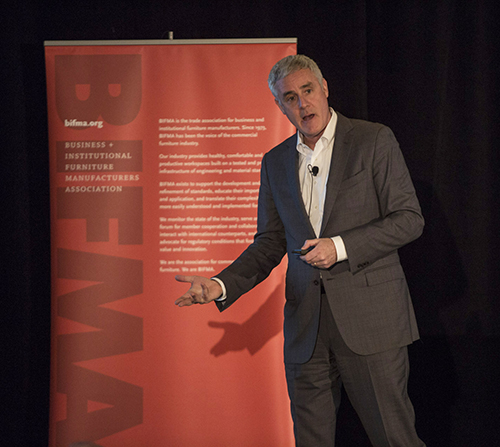
Dr. Coleman spoke about understanding the full complexity of a problem you’re dealing with, and how to think differently about problems.
>Leaders are being overwhelmed by multiple, intense pressures. We’ve been making this assertion for decades, but it’s now actually happening at a higher rate than ever before in history. IBM predicts that with the advent of the Internet of Things, knowledge will double every 12 hours within the next decade. In short, the rate of change across all issues is drastically increasing and putting new, overwhelming pressure on businesses.
>One effect of this problem, sometimes referred to as a “crisis of complexity,” is that when a problem is so overwhelming, we retreat and do nothing to right the course.
>Problems can be understood as either “clock problems” or “cloud problems.” Clock problems have relatively clear components and direct resolutions, while cloud problems have more undefined edges/consequences. Our more difficult challenges work like clouds. An example of a cloud problem is Brexit, in which the British vote to leave the EU will have countless direct and indirect consequences that will be difficult to untangle and resolve.
Dr. Coleman is Director of the Morton Deutsch International Center for Cooperation and Conflict Resolution at Teachers College, Columbia University. His most recent book is “Making Conflict Work: Navigating Disagreement Up and Down Your Organization.”
Paul Scialla – Wellness
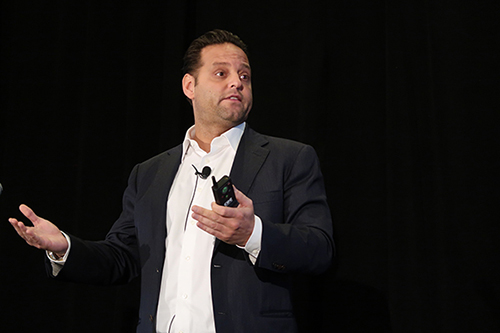
Mr. Scialla provided an introduction to the WELL Building Standard, launched a little under two years ago.
“We spend 90% of our time indoors, and that’s not a normal condition for the human body. The fact that we’re sitting in this room, for instance, is having an immediate impact on our health. WELL helps people and organizations unlock human potential through their buildings.
“Medical science and building science had never communicated together. We’ve done significant academic, medical and political vetting to develop WELL. Standards like this are asking a lot of different, formerly non-communicative groups and industries to begin speaking to each other and working together.”
>WELL certification costs about $100 per employee, and the IWBI see its future expanding into other avenues of development – schools, homes, and master planning at the community level. It’s working right now on gathering medical evidence of working in a WELL building versus not. “The insurance industry is the next big shoe to drop. We don’t need insurance companies and government entities to adopt this into policy, but we think that’s where it’s going.” Chicago policymakers, for instance, are already looking at buildings and certification systems and ways of integrating them with healthcare policies.
After 18 years on Wall Street, including 10 at Goldman Sachs as a Partner, Paul’s interest in sustainability and altruistic capitalism led him to found Delos, which is merging the world’s largest asset class – real estate – with the world’s fastest growing industry – wellness. Paul is also the Founder of the International WELL Building Institute (IWBI), which administers the WELL Building Standard (WELL) globally to improve human health and wellbeing through the built environment.
Dr. Marci Rossell – An Economic Forecast for 2017: A Roadmap for Businesses
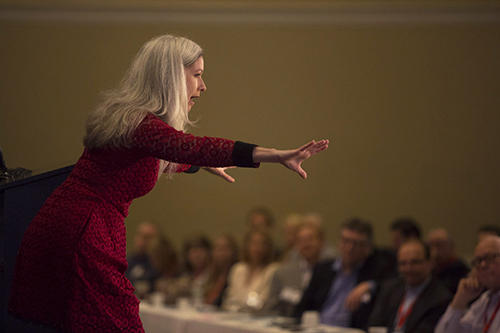
Dr. Rossell gave a super engaging, big-picture view of the global economy, and what will be affecting the U.S. in both the short term and long term, particularly through the lens of the recent U.S. election.
>The short-term aftermath of the election is a bond market decline, with an increase in interest rates, and a stock market rally, with the prospect of corporate tax cuts and significant deregulation.
>But, the bigger market force is a significant increase in the strength of the dollar, which is responsible for all kinds of effects, including, for example, the loss of about 63,000 jobs last year.
>We can expect three major trends that will have long-term effects on our economy:
- Globalization is giving way to nationalism. These two things come in waves. Look to Brexit and the election of Donald Trump as signs of this current move toward nationalism. We can expect trade blocks and more regional/bilateral trade agreements. In short, “it’s about to get messy.”
- The focus on China will give way to a focus on India. While China will continue to be an important country on the world stage, its growth has slowed, and we won’t talk about them the same way. India will be the next China, but with a few key differences: India already has a long-term appreciation for western values, and many already know English, which cuts down several barriers. India’s challenge lies in gender equality; it will need to make a cultural change to make it acceptable to educate women and inject them into the workforce. Ms. Rossell gives India a 50/50 chance of actually doing that, and also noted that India’s growth will be much slower than in China overall.
- Boomers are giving way to Millennials. The arrival of the Millennials creates a unique demographic shift in the U.S.; now, we have lots of young people and lots of old people, rather than a traditional aging population. And while most people see Millennials as a rare, wild species (haha), Ms. Rossell predicts that they will do everything previous generations did economically; they’re just going to do it 10 years later. The recession affected Millennials more than any other generation, and they will be much more risk-averse for the rest of their lives.
As the Senior Economic Advisor for Delphin Investments, Dr. Rossell conducts analysis that provides insight into global economic and political developments, with investment research across equities, fixed income, currencies, and commodities. She was Chief Economist for CNBC and appeared every morning on the network’s flagship program, “Squawk Box,” covering the economy, the Federal Reserve, and the bond market.
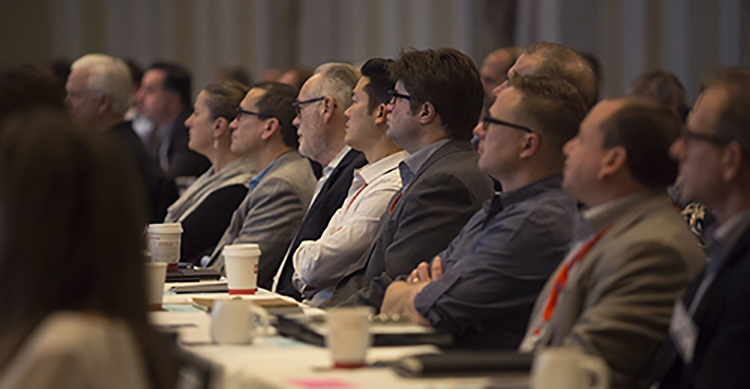
Dr. Michael Kimmel – The Gender Equality Advantage
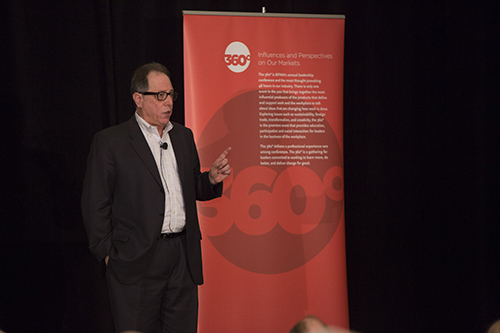
Dr. Kimmel is an expert on men and masculinities – and he offered conference attendees an opportunity to think about gender equality from the male perspective. When we first think of “gender” and “gender equality,” our minds often jump straight to the female gender. Dr. Kimmel’s presentation challenged attendees to think about the barriers that prevent men from seeing true gender quality as an advantage specifically for men.
While gender equality efforts tend to focus on women successfully adopting historically “male” traits – things like expertise in male-dominated STEM fields, bold decision-making, and risk-taking, men see the very things that are characterized as “female” – empathy, superior listening skills, nurturing – as weak, so they won’t adopt them.
“Women are starting to flourish and succeed, and men perceive themselves as weakening as a result. But the two are not logically connected that way.”
Michael Kimmel is one of the world’s leading experts on men and masculinities. He is the SUNY Distinguished Professor of Sociology and Gender Studies at Stony Brook University. A tireless advocate of engaging men to support gender equality, Kimmel has lectured at more than 300 college, universities and high schools. He consults widely with corporations, NGOs and public sector organizations on gender equality issues.
John Dickerson – Political Outlook/State of the Union
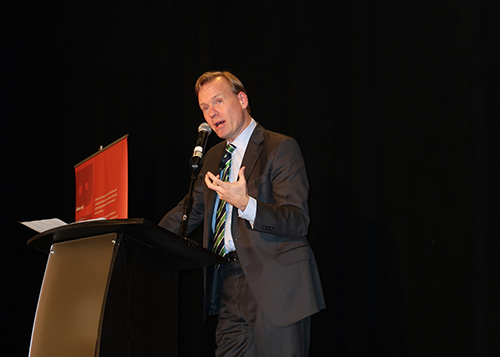
Mr. Dickerson offered commentary on the current political climate and the unique dynamics of the new Trump presidency.
Among other things, he noted that in order to be successful, President Trump will need to grow beyond the constituency base that got him elected. Whether he learns that sooner or later is a big guess, but if/when he does, he is set up to accomplish things neither democrats or republican could pass.
He also spoke about the tension between the Trump Administration and the media, and the war on facts, alternative facts, and fact-checking. “First, the distortion of what ‘breaking news’ is and the overhyping of everything has led to distrust of the media. And, all websites, blogs and ‘media outlets’, both professional and amateur, look relatively the same, which also leads to confusion.”
America is also becoming more partisan-based; people are only interacting with people of similar beliefs – because we naturally seek things that soothe us and confirm what we already believe. So, instead of people having a “difference of beliefs,” the lens people see each other through is shifting to “good versus evil.”
“But, a belief is a filter through which you analyze things; you’re supposed to analyze challenges to your beliefs. And to a certain extent, we’ve stopped doing that.”
Dickerson is the host of CBS News’ “Face the Nation”, the Political Director of CBS News, and a columnist for Slate magazine. He has been a reporter in Washington for almost 20 years covering the White House, Congress and political campaigns. Before joining Slate, Dickerson was with TIME magazine for almost fifteen years, and has also written for the New York Times and Washington Post.

Dan Gardner – Risk & Superforecasting

Mr. Gardner spoke about forecasting and its impact on decision-making.
>Excellent forecasters have one goal: accuracy. But in business, accuracy often isn’t the only goal. As an employee, you want to provide something accurate to your boss, but you may also want to do it quickly, or want to present something positive – something that your boss will like to hear. Leaders need to create an environment in which people feel safe in speaking up and making accurate, but not always pleasant, statements.
>One effective technique in forecasting involves “unpacking the question.” This means drilling the question – whatever you are trying to predict or answer – down to simpler questions – to a point where you can’t drill down any further. Then, you answer all of the simpler questions, working your way back up to the original question. The thinking here is that the answer you find will be more accurate than if you had just guessed.
Dan Gardner is a journalist who examines the processes by which we forecast the future, in order to facilitate decision-making. Known for his work on forecasting, risk and decision-making, he offers demonstrably more effective ways to predict what’s coming – invaluable knowledge for business, finance, politics, international affairs, and daily life. His most recent book, co-authored with Stephen Tetlock, is “Superforecasting: The Art and Science of Prediction.”
Denise Lee Yohn – How to Build a Rock Star Brand
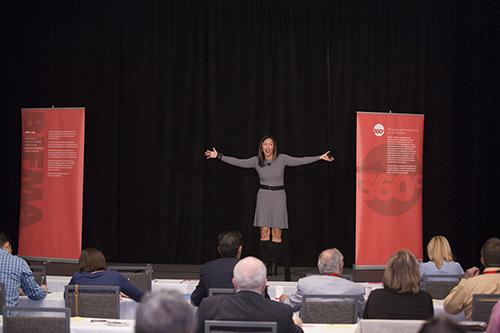
The seven things great brands do are:
- Start inside. Begin brand-building by cultivating a strong brand-led culture inside their organizations. Great brands don’t operate with their brand separate, off to the side from their business. A brand is what you do, and how you do it.
- Avoid selling products. Seek to develop emotional connections with customers instead of pushing products, making claims, or promoting features. What business are you really in? As an example, Cirque de Soleil transformed the circus into theater.
- Ignore trends. Challenge the status quo and advance their own movements instead of following what everyone else is doing. Are you leading, or are you following?
- Don’t chase customers. Project their brand identities like lighthouses and attract like-minded customers. You cannot be all things to all people, and you shouldn’t try to be. Invite the world to navigate around you.
- Sweat the small stuff. Seek out opportunities to express their brands in the finest details of execution. Sweating the small stuff is not about being anal or chasing perfection; it means being intentional, focusing your research on things that matter, and looking at all touchpoints in your business, from product design and operations down to details like the confirmation screen a customer sees after purchasing.
- Never have to “Give Back.” Make a positive social impact in the core of their operations and create value that all their stakeholders share. Great brands weave social goals natural into all facets of its culture and business.
- Commit and stay committed. Have the commitment and discipline to reject anything that causes them to lose focus on their brand core. Great brands resist things like boredom, losing focus, and pressure to product short-term results in order to remain focused on long-term goals. Think: what should you say no to?
At the center of all of these is an eighth and final quality: great brands do “Brand as Business.” They put their brand at the center of their organization and use it to drive, align and guide everything they do. Your brand becomes your central operating organism to manage your business.
Denise Lee Yohn is the go-to expert on brand-building for national media outlets, an in-demand speaker and consultant, and an influential writer. She served as lead strategist at advertising agencies for Burger King and Land Rover and as the marketing leader and analyst for Jack in the Box restaurants and Spiegel catalogs. Denise went on to head Sony Electronic Inc.’s first ever brand office, where she was the vice president/general manager of brand and strategy. She is the author of the bestselling book “What Great Brands Do: The Seven Brand-Building Principles that Separate the Best from the Rest.”
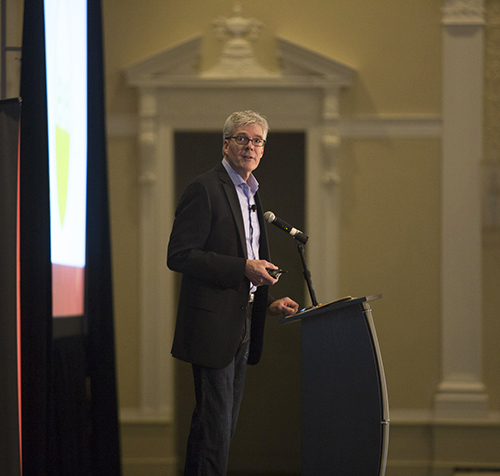
We also heard from Tom Reardon, executive director of BIFMA, who provided an updated on the most pressing recent BIFMA news. BIFMA is continuing to grow the capabilities and compatibility of its level sustainability standard, so that more people can use and apply it to related efforts. Mr. Reardon also reported that BIFMA’s initiative to gather data from its member companies is on schedule with projected goals.













